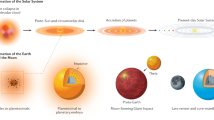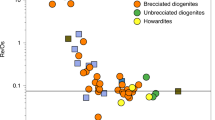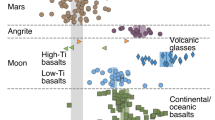Abstract
ACCORDING to several theories1–3, the Earth was formed by accretion from a mixture of silicate particles and metal particles, something like those in chondritic meteorites. The accreting material may also have contained relatively small quantities of other components such as iron meteorites4 and carbonaceous chondrites5. Most advocates of these theories have maintained that accretion occurred relatively slowly (over a period of about 108 yr), so that the gravitational potential energy was efficiently radiated away and the Earth formed in a relatively cool and unmelted condition. Subsequently, heating by long lived radioactive elements occurred, leading to melting of the metal phase and segregation of the core. Differentiation and formation of the core may thus have occurred much later than the primary accretion of the Earth. It has even been argued that core formation might not yet have proceeded to completion1,6,7. On the other hand, alternative theories of origin of the Earth8–10,11 have maintained that much of the accretion of the Earth occurred in high temperature conditions and that core formation occurred either during accretion or very soon afterward. Clearly, an independent determination of the time interval ΔTc between accretion and core formation would have a crucial bearing on these contrasting theories.
This is a preview of subscription content, access via your institution
Access options
Subscribe to this journal
Receive 51 print issues and online access
$199.00 per year
only $3.90 per issue
Buy this article
- Purchase on Springer Link
- Instant access to full article PDF
Prices may be subject to local taxes which are calculated during checkout
Similar content being viewed by others
References
Urey, H. C., The Planets (Yale University Press, 1952).
Kuiper, G. P., in The Atmospheres of the Earth and Planets, Ch. 12 (edit. by Kuiper, G. P.) (University of Chicago Press, 1952).
Wood, J. A., Nature, 194, 127 (1962).
Birch, F., Bull. Geol. Soc. Amer., 76, 133 (1965).
Larimer, J., and Anders, E., Geochim. Cosmochim. Acta, 31, 1239 (1970).
Runcorn, S. K., in Continental Drift, Ch. 1 (edit. by Runcorn, S. K.) (Academic Press, New York, 1962).
Munk, W. H., and Davies, D., in Isotopic and Cosmic Chemistry, Ch. 22 (edit. by Craig, H., Miller, S., and Wasserburg, G.) (North-Holland, Amsterdam, 1964).
Ringwood, A. E., Geochim. Cosmochim. Acta, 20, 241 (1960).
Ringwood, A. E., Geochim. Cosmochim. Acta, 30, 41 (1966).
Hanks, T. C., and Anderson, D. L., Phys. Earth Planet. Interiors, 2, 19 (1969).
Cameron, A. G. W., Trans. Amer. Geophys. Un., 51, 628 (1970).
Murthy, V. R., and Patterson, C. C., J. Geophys. Res., 67, 1161 (1962).
Patterson, C., Geochim. Cosmochim. Acta, 10, 230 (1956).
Cooper, J. A., Reynolds, P. H., and Richards, J. R., Earth Planet Sci. Lett., 6, 467 (1969).
Stacey, J. S., Delevaux, M. H., and Ulrych, T. J., Earth Planet. Sci. Lett., 6, 15 (1969).
Patterson, C., and Tatsumoto, M., Geochim. Cosmochim. Acta, 28, 1 (1964).
Birch, F., J. Geophys. Res., 57, 227 (1952).
Birch, F., Geophys. J. Roy. Astron. Soc., 4, 295 (1961).
MacDonald, G. J. F., and Knopoff, L., Geophys. J., 1, 284 (1958).
Urey, H. C., in Physics and Chemistry of the Earth, Vol. 2, Ch. 5 (edit. by Ahrens, L., Press, F., Rankama, K., and Runcorn, S.) (Pergamon, New York, 1957).
Vinogradov, A. P., Geochemistry (English translation), 1 (1961).
Elsasser, W. M., in Earth Science and Meteoritics, Ch. 1 (edit. by Geiss, J., and Goldberg, E.) (North-Holland, Amsterdam, 1963).
Murthy, V. R., and Hall, H. T., Phys. Earth Planet Interiors, 2, 276 (1970).
Green, D. H., and Ringwood, A. E., Geochim. Cosmochim. Acta, 31, 767 (1967).
Oversby, V. M., Compston, W., and Penikis, E., Earth Planet Sci. Lett., 10, 121 (1970).
Green, D. H., and Ringwood, A. E., Contrib. Mineral. Petrol., 15, 103 (1967).
Oversby, V. M., Geochim. Cosmochim. Acta, 34, 65 (1970).
Tatsumoto, M., Science, 153, 1094 (1966).
Author information
Authors and Affiliations
Rights and permissions
About this article
Cite this article
OVERSBY, V., RINGWOOD, A. Time of Formation of the Earth's Core. Nature 234, 463–465 (1971). https://doi.org/10.1038/234463a0
Received:
Revised:
Issue Date:
DOI: https://doi.org/10.1038/234463a0
This article is cited by
-
Marine Carbonates in the Mantle Source of Oceanic Basalts: Pb Isotopic Constraints
Scientific Reports (2018)
-
Hard core constraints on accretion
Nature Geoscience (2010)
-
The Earth’s missing lead may not be in the core
Nature (2008)
-
Mantle Pb paradoxes: the sulfide solution
Contributions to Mineralogy and Petrology (2006)
-
Pb–Sr–Nd isotopic correlation and the chemistry of the North Atlantic mantle
Nature (1980)
Comments
By submitting a comment you agree to abide by our Terms and Community Guidelines. If you find something abusive or that does not comply with our terms or guidelines please flag it as inappropriate.



